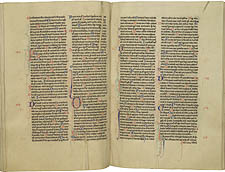English Bible
![]()
Established in the fourth century, largely by St. Jerome, the Vulgate
Bible was so named because it was popular (the Latin vulgus means "the
people"). The copy shown here displays several characteristics of
the standard Vulgate text adopted in the schools of Paris during the thirteenth
century, such as the order of the books and the way they are divided into
chapters. Shown are Psalms 107–116, as the rubricated medieval Arabic
numerals in the margins indicate. Among the red and blue initials in the
text, the large capitals mark the beginning of a new Psalm, and the smaller
capitals introduce a new verse. Medieval scribes used these colored letters
instead of indentation to start a new paragraph.
![]()
Vulgate Bible. England, latter half of the 13th
century.![]()

Copyright
© 2002 Division of Rare & Manuscript
Collections
2B Carl A. Kroch Library, Cornell University, Ithaca, NY, 14853
Phone Number: (607) 255-3530. Fax Number: (607) 255-9524
For
reference questions, send mail to:
rareref@cornell.edu
If you have questions or comments about the site, send mail to: webmaster.
